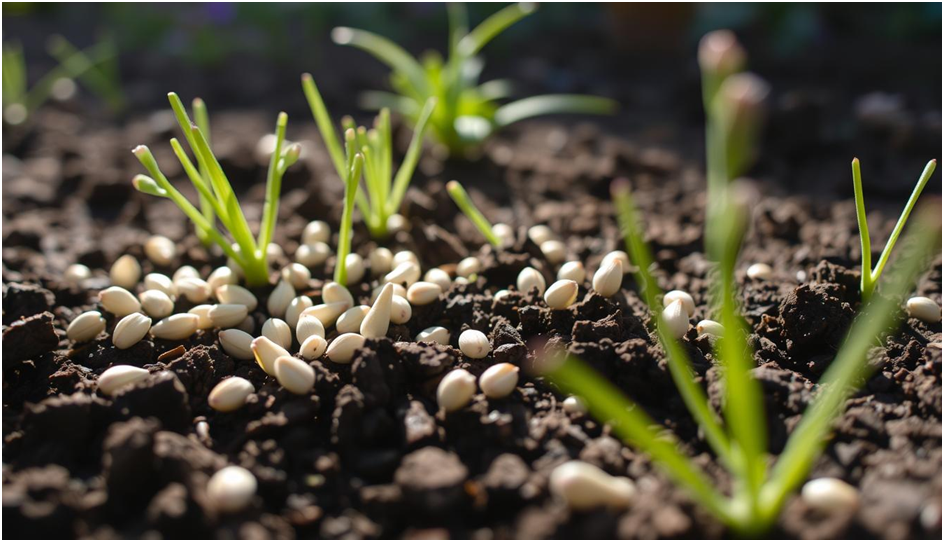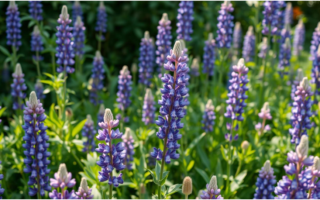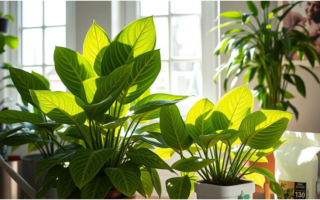Table of Contents
Starting your gardening journey? You’ll soon learn about lupin seeds’ many benefits. They’re not just good for you but also add beauty to gardens. Growing lupin seeds can make your garden more interesting and nutritious.
Thank you for reading this post, don't forget to subscribe!With the right tips, you can make the most of lupin seeds. This guide will help you grow a beautiful wild lupine garden. It’s perfect for both new and experienced gardeners, covering everything from planting to care.
Key Takeaways
- Understanding the benefits of lupin seeds can enhance your gardening experience
- Lupin seeds offer a unique opportunity for gardeners to cultivate a versatile and protein-rich crop
- Wild lupine landscapes can inspire and inform your gardening decisions
- Planting lupin seeds requires careful consideration of factors such as soil and light
- With the right guidance, you can unlock the full potential of lupin seeds and enjoy a bountiful harvest
- Cultivating lupin seeds can be a rewarding and enjoyable experience for gardeners of all levels
Understanding Lupin Plants: From Wild Lupine to Garden Varieties
Lupin plants come in many types, from wild lupine found in America to garden varieties grown for their looks and health benefits. Each type has its own special traits, like how they grow, what soil they need, and how they can be used.
There are many lupin seeds to pick from, depending on what you want in your garden. You might want to attract bees, brighten up your yard, or use the seeds in cooking. Garden lupins are great because they can grow well in poor soil and even help fertilize it.
Native American Lupine Species
Native American lupines, like the Texas bluebonnet, are known for their bright colors and ability to thrive in tough places. These wild lupines have learned to survive in their native lands. They’re perfect for gardeners who want to bring a bit of the wild into their gardens.
Popular Garden Varieties
Popular garden lupins, like the Russell lupine, come in many colors and shapes. They’re great for gardeners because they can grow in different ways and have nice traits like fragrant flowers. They can make your garden look amazing with their vibrant colors.
Key Characteristics of Lupins
When picking lupin seeds or varieties, think about what lupins are like. Look at their growth, soil needs, and uses. Knowing these things helps you choose the right lupin plants and take good care of them. This way, you’ll have a great gardening experience.
Why Choose Lupin Seeds for Your Garden
Lupin seeds are a great pick for your garden. They are packed with benefits of lupin seeds like high nutrition and easy growth. They add protein and fiber to your garden, making them a nutritious choice. Plus, they are low in calories and full of antioxidants.
Here are some key reasons to plant lupin seeds:
- Easy to grow and maintain
- Rich in nutrients, including protein and fiber
- Low in calories and rich in antioxidants
- Supports a healthy garden ecosystem
Adding lupin seeds to your garden boosts plant health. The benefits of lupin seeds go beyond nutrition. They help create a balanced garden ecosystem. By planting lupin seeds, you foster a diverse, nutrient-rich garden. This supports a wide range of plant life, making them perfect for a sustainable garden.
| Benefits of Lupin Seeds | Description |
| Nutritional Value | Rich in protein, fiber, and antioxidants |
| Ease of Growth | Easy to grow and maintain |
| Health Benefits | Low in calories, rich in antioxidants |
Essential Growing Requirements for Lupin Seeds
To grow lupin seeds well, you need to know a few key things. First, prepare the soil right. Then, give them enough light and the right temperature. You can even use lupin seeds to make natural fertilizers, which helps your plants grow strong.
Ideal Soil Conditions
Lupin seeds do best in soil that drains well and is slightly acidic. The pH should be between 6.0 and 7.0. You can test your soil to see its pH level and adjust it if needed. Adding compost or manure can also make the soil better for your plants.
Light Requirements
Lupin seeds need full sun to partial shade, depending on the type. Pick a spot that gets enough light for your lupin. Cooking lupin seeds is also a fun way to use them, and there are lots of recipes online.
Some benefits of growing lupin seeds include:
- High protein content
- Rich in fiber and nutrients
- Can be used as a natural fertilizer
By following these tips and trying out different recipes, you can grow and use lupin seeds in your garden.
| Soil pH | Ideal Range |
| Lupin Seeds | 6.0-7.0 |
When to Plant Your Lupin Seeds
Before planting your lupin seeds, think about the best time for growth. Lupin seeds grow well in cooler weather. Spring or fall are the best times to plant them.
For lupin seeds recipes, plant them in early spring. This allows them to grow and produce seeds for your dishes. Lupin seeds also offer lupin seeds health benefits, making them a nutritious choice.
Consider these factors when planting lupin seeds:
- Climate: They do best in cooler temperatures, avoiding extreme heat or cold.
- Season: Spring or fall are the best seasons for planting lupin seeds.
- Location: Check the specific planting times for your region, as they may vary.
Planting lupin seeds at the right time ensures a good harvest. Enjoy their lupin seeds health benefits in lupin seeds recipes or as a snack. They are a valuable addition to any garden.
| Season | Planting Time | Climate |
| Spring | 6-8 weeks before last frost | Cooler temperatures |
| Fall | 8-10 weeks before first frost | Cooler temperatures |
Preparing Your Garden Soil for Lupin Seeds
To get your lupin seeds to grow well, you need to prepare your soil. This means testing and improving the soil, making sure it drains right, and adjusting the pH. These steps help make your soil rich in nutrients, which is good for the lupin seeds nutrition and their benefits.
Soil testing is key. It tells you what your soil’s pH and nutrient levels are. You can buy a kit or ask a gardening expert for help.
Soil Testing and Amendment
After testing, you might need to add compost or manure to your soil. This makes the soil better for your lupin seeds, giving them the nutrients they need to grow.
Drainage Improvements
Good drainage is important for lupin seeds. You can add organic matter or install a drainage system. This keeps the soil from getting too wet, which is bad for your plants.
pH Balance Adjustments
Lupin seeds do best in slightly acidic to neutral soil, with a pH of 6.0 to 7.0. If your soil’s pH is off, you might need to use lime or sulfur. This helps your lupin seeds grow well.
Step-by-Step Guide to Planting Lupin Seeds
To start planting lupin seeds, soak them in water for 24 hours. This softens the seed coat and boosts germination. After soaking, plant the seeds 1-2 inches deep and 6-8 inches apart in a seed tray or directly in the ground.
While waiting for your lupin seeds to grow, think about how to cook them. Lupin seeds are great in salads, soups, and more. They can be boiled, roasted, or sautéed.
Here are some steps to follow for planting lupin seeds:
- Choose a location with well-draining soil and full sun to partial shade.
- Plant the seeds at the correct depth and spacing.
- Water the seeds regularly, but avoid overwatering.
- Keep the soil consistently moist during the first few weeks after planting.
By following these steps and exploring different ways to cook lupin seeds, you can enjoy a bountiful harvest. Discover the delicious flavor and nutritional benefits of lupin seeds.
| Seed Depth | Spacing | Watering |
| 1-2 inches | 6-8 inches | Regular, but avoid overwatering |
Water and Maintenance Requirements
To enjoy the health benefits of lupin seeds, proper care is key. Healthy lupin plants need the right amount of water, food, and pruning. Follow these tips to make sure your plants grow well and give you a good harvest.
Proper care is crucial for growing lupin seeds successfully. Knowing what your plants need helps them grow and gives you the most health benefits.
Watering Schedule
Lupin plants need steady moisture, especially when they’re germinating and flowering. A good watering schedule is important. It helps avoid too much or too little water, which can harm your plants.
Fertilization Tips
Fertilize your lupin plants often to help them grow strong. Use a balanced fertilizer and follow the label’s instructions. Don’t overdo it.
Pruning Guidelines
Pruning keeps your lupin plants looking good and growing well. Remove dead or damaged parts. Cut back the plant after it flowers to encourage new growth and more seeds.
By following these care tips, you can enjoy the many health benefits of lupin seeds. Stay consistent with your care to make sure your plants thrive and give you a great harvest.
| Maintenance Task | Frequency | Importance |
| Watering | Regular | High |
| Fertilization | Monthly | Medium |
| Pruning | After flowering | High |
Common Challenges When Growing Lupins
Growing lupins can come with several challenges. Wild lupine is tough but can still face issues. Knowing these challenges helps you grow healthy plants.
Challenges include pests, diseases, and environmental factors. To tackle these, it’s key to be proactive. Here are some common problems and how to solve them:
- Pests: Use organic pest control methods, such as introducing beneficial insects or using neem oil, to minimize harm to your lupin seeds and the environment.
- Diseases: Practice good hygiene, remove infected plants, and treat your lupin seeds with fungicides to prevent the spread of disease.
- Environmental factors: Choose a location with suitable climate and soil conditions for your lupin seeds, and be prepared to provide support during extreme weather events.
By understanding and addressing these challenges, you can grow healthy lupins. This is true for both wild lupine and cultivated seeds.
With the right care, your lupin seeds will thrive. You’ll enjoy the benefits of these versatile and nutritious plants.
| Challenge | Solution |
| Pests | Organic pest control methods |
| Diseases | Good hygiene, removal of infected plants, and fungicides |
| Environmental factors | Suitable location, support during extreme weather events |
Harvesting and Storing Lupin Seeds
As the growing season ends, it’s time to harvest your lupin seeds. This step is key to keeping their lupin seeds nutrition and quality for planting later. You can also use these seeds in tasty lupin seeds recipes, adding to the fun.
When to Harvest
Harvest lupin seeds when the pods are brown and dry. Check if they’re dry by shaking the pods. If the seeds inside rattle, they’re ready.
Proper Storage Methods
To keep the lupin seeds nutrition and quality, store them in a cool, dry spot. Use airtight containers or paper bags to keep them fresh. Make sure to keep them away from sunlight and moisture.
Seed Viability
Good storage keeps the seeds viable for planting later. You can also use them in lupin seeds recipes, making it more enjoyable. Follow these steps for a successful harvest and enjoy your lupin seeds for a long time.
The Nutritional Power of Lupin Seeds
Lupin seeds are packed with nutrients, offering many health benefits. They are a great source of protein, fiber, and essential nutrients. The lupin seeds health benefits come from their high protein, making them perfect for vegetarians and vegans.
The benefits of lupin seeds also include their fiber, which helps lower cholesterol and control blood sugar. They are also rich in minerals like potassium, magnesium, and iron. Here are some key nutritional benefits of lupin seeds:
- High protein content: 30-40% of the seed’s weight
- High fiber content: 20-30% of the seed’s weight
- Rich in minerals: potassium, magnesium, and iron
- Low in calories: approximately 100-150 calories per 100g serving
Adding lupin seeds to your diet can improve heart health, help with weight management, and reduce inflammation. With their high nutritional value, lupin seeds are a fantastic addition to a healthy diet.
Culinary Uses for Your Harvested Lupins
Now that you’ve harvested your lupin seeds, it’s time to get creative in the kitchen. Learning to cook lupin seeds is fun and opens up a world of flavors. You can try everything from classic dishes to new recipes.
Lupin seeds are great in salads, as a protein in veggie dishes, and in baked goods. You can even make flour from them for baking bread or pancakes.
Traditional Preparations
Traditionally, lupin seeds are soaked and boiled to remove bitterness. This method takes time but is worth it for their unique taste and health benefits.
Modern Recipes
Today, lupin seeds are used in many creative ways. You can make lupin seed hummus or energy balls. Look online for recipes or try your own with lupin seeds.
Safety Considerations
When cooking lupin seeds, safety is key. Make sure to soak and cook them well to remove toxins. Store them in a cool, dry place to keep them safe.
| Recipe | Ingredients | Instructions |
| Lupin Seed Salad | Lupin seeds, mixed greens, cherry tomatoes, cucumber | Soak lupin seeds overnight, then mix with greens, cherry tomatoes, and cucumber |
| Lupin Seed Bread | Lupin seeds, flour, yeast, water | Grind lupin seeds into flour, then mix with yeast, water, and flour to make a delicious bread |
Your Path to Lupin Growing Success
Lupin seeds are a great addition to any garden. They offer many benefits, from their nutritional value to their easy growth. Now, it’s time to start your lupin growing journey and explore the wonders of this versatile plant.
Wild lupine’s vibrant blooms or the adaptability of garden varieties will surely enhance your garden. With proper soil, planting, and care, you’ll enjoy a rich harvest. You can then use these seeds in your cooking.
So, what are you waiting for? Start growing lupins and enjoy the process. This guide will help you on your path to success. Happy planting!
FAQ
What are the key benefits of growing lupin seeds?
Lupin seeds are great for your garden and health. They’re packed with protein, fiber, and vitamins. They also help fix nitrogen in the soil, making it better for other plants.
They’re easy to grow and work well in many climates. This makes them perfect for gardeners of all levels.
How do I prepare my garden soil for planting lupin seeds?
Soil preparation is crucial for lupin seeds. First, test your soil to check its pH and nutrient levels. Adjust the pH to a neutral to slightly acidic range if needed.
Add compost or aged manure to enrich the soil and improve drainage. This will help your lupin seeds grow well.
When is the best time to plant lupin seeds?
The best time to plant lupin seeds varies by climate and variety. Generally, plant in early spring or late fall when the soil is cool. Avoid planting in the hottest summer months.
Check your frost dates and plant accordingly. This ensures your seeds germinate and grow strong.
How do I care for my lupin plants after planting?
After planting, lupin plants need regular care. Water them consistently but avoid overwatering. Use a balanced fertilizer to feed them.
Prune spent flowers and dead foliage to promote more blooms. Watch for pests and diseases and treat them quickly.
What are some delicious ways to use harvested lupin seeds?
Lupin seeds are versatile and can be used in many dishes. Roast them for a crunchy topping on salads or soups. You can also grind them into flour for baking.
Use lupin flour in gluten-free breads or muffins. You can even make plant-based milk from them. Get creative with your lupin seeds!














